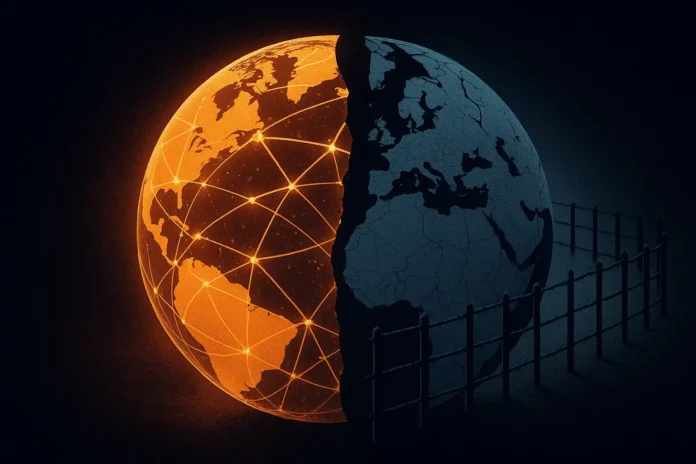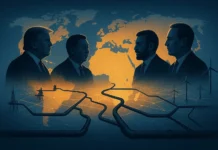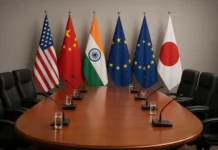Globalization has defined the modern world for over three decades. From the fall of the Berlin Wall to the digital revolution, it transformed economies, connected societies, and reshaped political alliances. Yet, as we enter the mid-21st century, the very foundation of globalization appears to be shifting. Rising protectionism, technological nationalism, and geopolitical rivalries are forcing nations to rethink how deeply they should be interconnected.
Is the future of globalization about renewed global cooperation, or will it descend into competitive fragmentation? Understanding this question is critical, as the outcome will determine how wealth, technology, and power are distributed across the planet in the coming decades.
The Rise and Transformation of Globalization
The late 20th century marked the golden age of globalization. The liberalization of trade, expansion of multinational corporations, and the emergence of global supply chains created an interconnected economy. Developing nations such as China and India became central players, lifting billions out of poverty.
However, globalization’s success also sowed the seeds of inequality. Wealth concentrated in urban and industrial centers while rural populations and small economies lagged behind. By the 2010s, the narrative began to shift — globalization was no longer universally celebrated; it was contested.
The Turning Point: Crises and Containment
Several global shocks have accelerated the questioning of globalization’s future:
1. The 2008 Financial Crisis
The global financial meltdown exposed the vulnerabilities of interlinked financial systems. Economic contagion spread rapidly across borders, highlighting how globalization can amplify instability.
2. The COVID-19 Pandemic
The pandemic disrupted global supply chains, exposed overdependence on single manufacturing hubs (especially in Asia), and triggered a wave of protectionism. Nations prioritized domestic production of essentials — from vaccines to semiconductors — leading to a “de-globalization” sentiment.
3. The Ukraine Conflict and Geopolitical Realignment
Russia’s invasion of Ukraine redefined energy and food geopolitics. Western sanctions reshaped trade routes, while China and other emerging economies sought alternative alliances. The world began fragmenting into competing blocs, reminiscent of the Cold War era — but this time, driven by economics rather than ideology.
Globalization in Transition: From Efficiency to Resilience
For decades, globalization prioritized efficiency — producing goods where it was cheapest and moving them across the world seamlessly. Now, the focus is shifting toward resilience — securing supply chains, diversifying trade partners, and ensuring strategic autonomy.
- Nearshoring & Friendshoring: Companies are moving manufacturing closer to home or to politically aligned nations. For instance, U.S. firms are investing in Mexico and Vietnam instead of China.
- Digital Borders: Countries are enforcing data sovereignty laws, limiting where information can be stored or processed.
- Strategic Industries: Nations are protecting sectors like semiconductors, energy, and AI under the label of “national security.”
The new phase of globalization is therefore not disappearing — it’s restructuring.
Global Cooperation: The Case for a Shared Future
Despite growing divides, complete isolation is neither practical nor beneficial. Certain challenges — climate change, pandemics, cybersecurity, and AI regulation — require global coordination. Here’s why cooperation still holds power:
1. Economic Interdependence
Modern economies are too interlinked to function in isolation. A smartphone, for instance, may include design from the U.S., chips from Taiwan, software from India, and assembly in China. Decoupling entirely would be economically disastrous.
2. Collective Problem Solving
Issues like climate change or public health crises demand joint research, shared funding, and cross-border coordination. The Paris Agreement and global vaccine initiatives like COVAX are testaments to the necessity of collaboration.
3. Technology and Innovation
Innovation thrives on collaboration. International research partnerships in AI, biotechnology, and quantum computing accelerate progress far beyond what individual nations can achieve alone.
4. The Rise of Global Governance
Institutions like the G20, WTO, IMF, and World Bank continue to shape policy frameworks for fair trade, digital finance, and debt relief. While imperfect, these platforms ensure that dialogue remains possible, even amid rivalry.
Global Competition: The New Economic Reality
While cooperation is ideal, competition is fast becoming the defining feature of the new global order.
1. The U.S.–China Tech Rivalry
The U.S. and China are engaged in a strategic race over AI, semiconductor technology, and digital infrastructure. Export controls, sanctions, and competing investment zones indicate a long-term technological divide.
2. Energy and Resource Nationalism
Control over critical minerals (like lithium and cobalt) and renewable energy technology has become a matter of national interest. Countries are prioritizing resource security, even at the expense of global trade balance.
3. Digital Sovereignty
Nations are creating their own digital ecosystems — separate payment systems, data rules, and communication networks — to reduce dependency on global giants like Google, Meta, or Amazon. This “digital decoupling” further fragments globalization.
4. Fragmented Global Institutions
The WTO and other multilateral bodies face declining influence as bilateral and regional trade deals replace global consensus. Economic alliances like BRICS+, RCEP, and the EU’s Digital Markets Act are reshaping how globalization functions.
The Hybrid Future: “Selective Globalization”
Experts predict that the future won’t be pure cooperation or pure competition — but a hybrid system often called “selective globalization.”
In this model, countries collaborate in areas of mutual benefit but compete in strategic sectors.
-
Cooperation: Climate policy, public health, and scientific research.
-
Competition: AI, defense, trade, and energy independence.
-
Neutral Zones: Tourism, culture, education, and global finance continue to thrive as shared spaces.
This balanced model acknowledges the geopolitical realities of the 21st century while preserving the essential connectivity of global progress.
Impact on Businesses and Consumers
The redefined globalization directly influences corporations, investors, and everyday consumers:
-
Corporations: Must redesign supply chains to minimize political and logistical risk.
-
Investors: Need to analyze geopolitical exposure before investing in global equities.
-
Consumers: May face higher prices as manufacturing shifts from low-cost to “secure” regions.
-
Developing Nations: Have new opportunities to attract investment as companies diversify away from China — a phenomenon termed “China+1 strategy.”
Essentially, the global economy is entering a new equilibrium where stability is prioritized over maximum efficiency.
The Role of Technology in Shaping Globalization’s Future
Technology will be the ultimate driver of globalization’s next phase. Artificial intelligence, blockchain, and digital currencies are creating a “borderless economy” even as physical trade faces restrictions.
-
AI & Automation: Enable production anywhere with minimal labor cost differences.
-
Blockchain: Increases transparency in global supply chains and financial transactions.
-
Digital Currencies (CBDCs): Could redefine cross-border payments and trade settlements.
The digital layer of globalization might survive even when physical trade becomes more fragmented — leading to what some economists call “Digital Globalization 2.0.”
Can Cooperation Win Over Competition?
The answer lies in leadership and trust.
If major powers recognize that global prosperity is a shared goal, cooperation can prevail. However, if geopolitical ambitions overshadow collective welfare, competition will dominate — leading to inefficiency and slower growth.
The next decade will likely see a tug-of-war between these two forces, defining how nations rebuild trust in an era of rising nationalism.
Conclusion
The future of globalization is neither a story of total cooperation nor complete competition — it’s a nuanced evolution toward selective interdependence.
Nations will continue to trade, innovate, and collaborate, but with caution and strategic intent.
Globalization is not dying; it is adapting — becoming smarter, digital, and more diversified.
The challenge ahead lies not in choosing between cooperation and competition, but in mastering the balance between the two.
Only then can the world sustain prosperity in an increasingly divided yet interconnected era.






